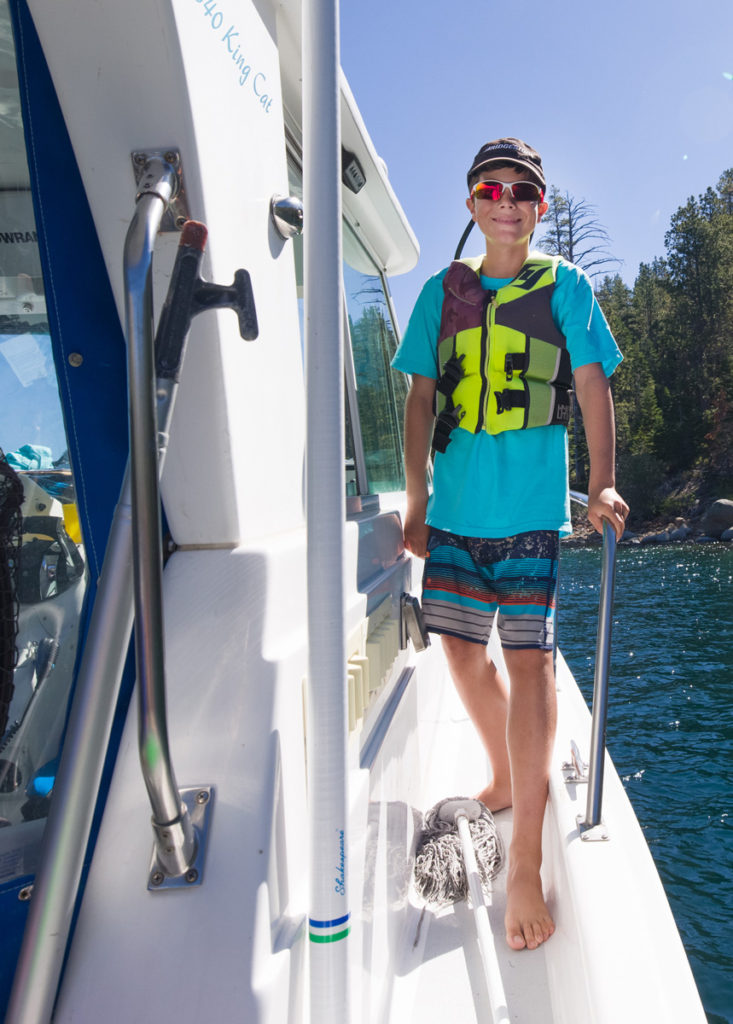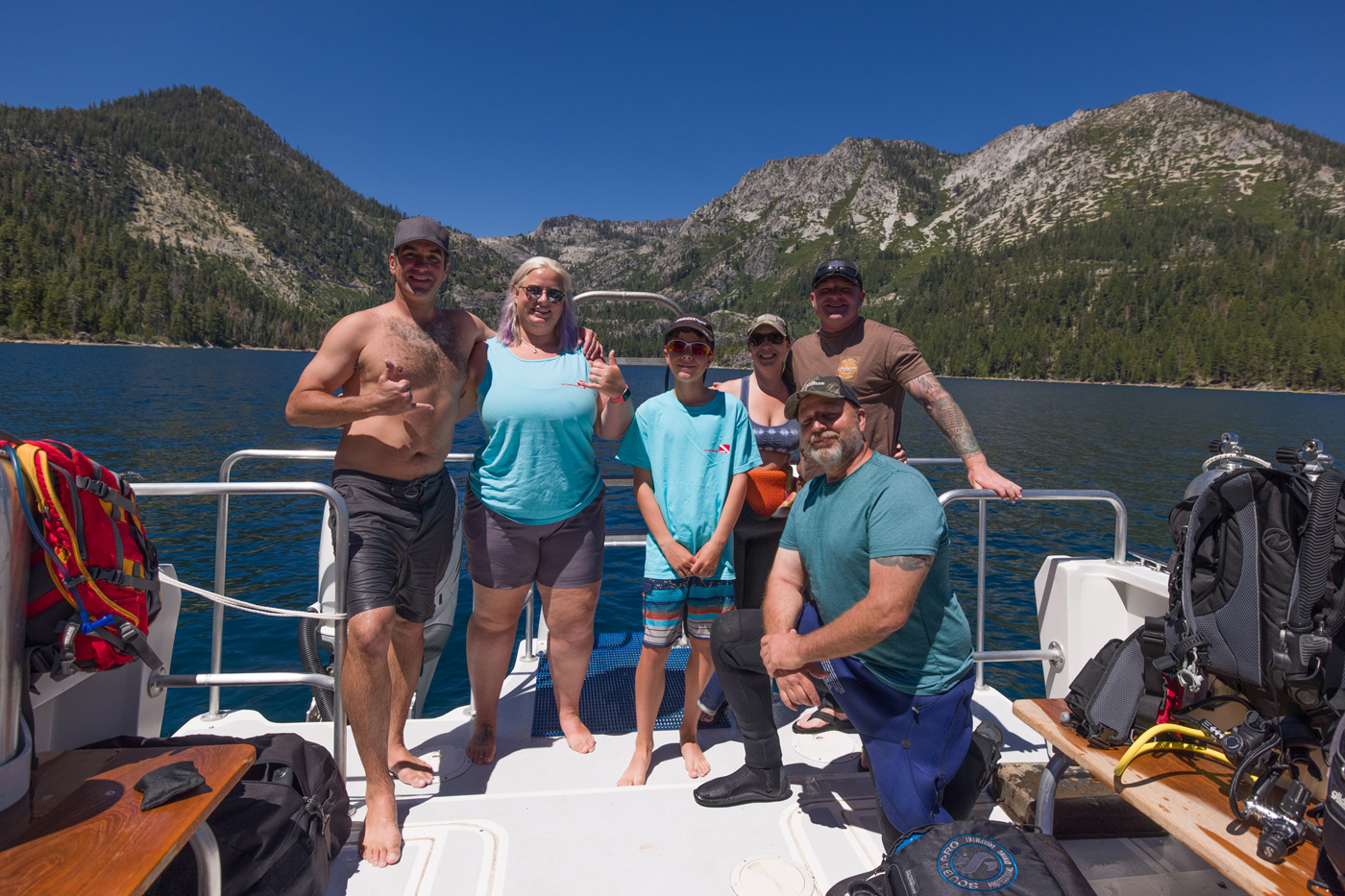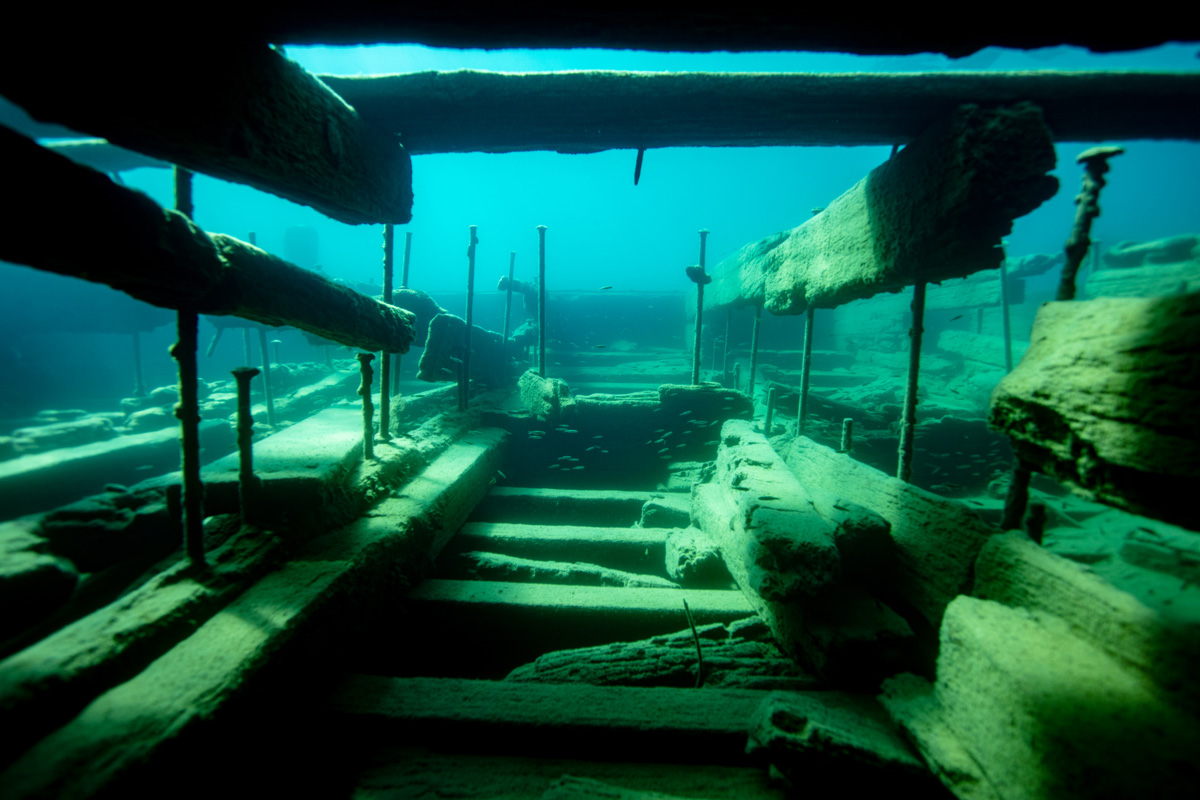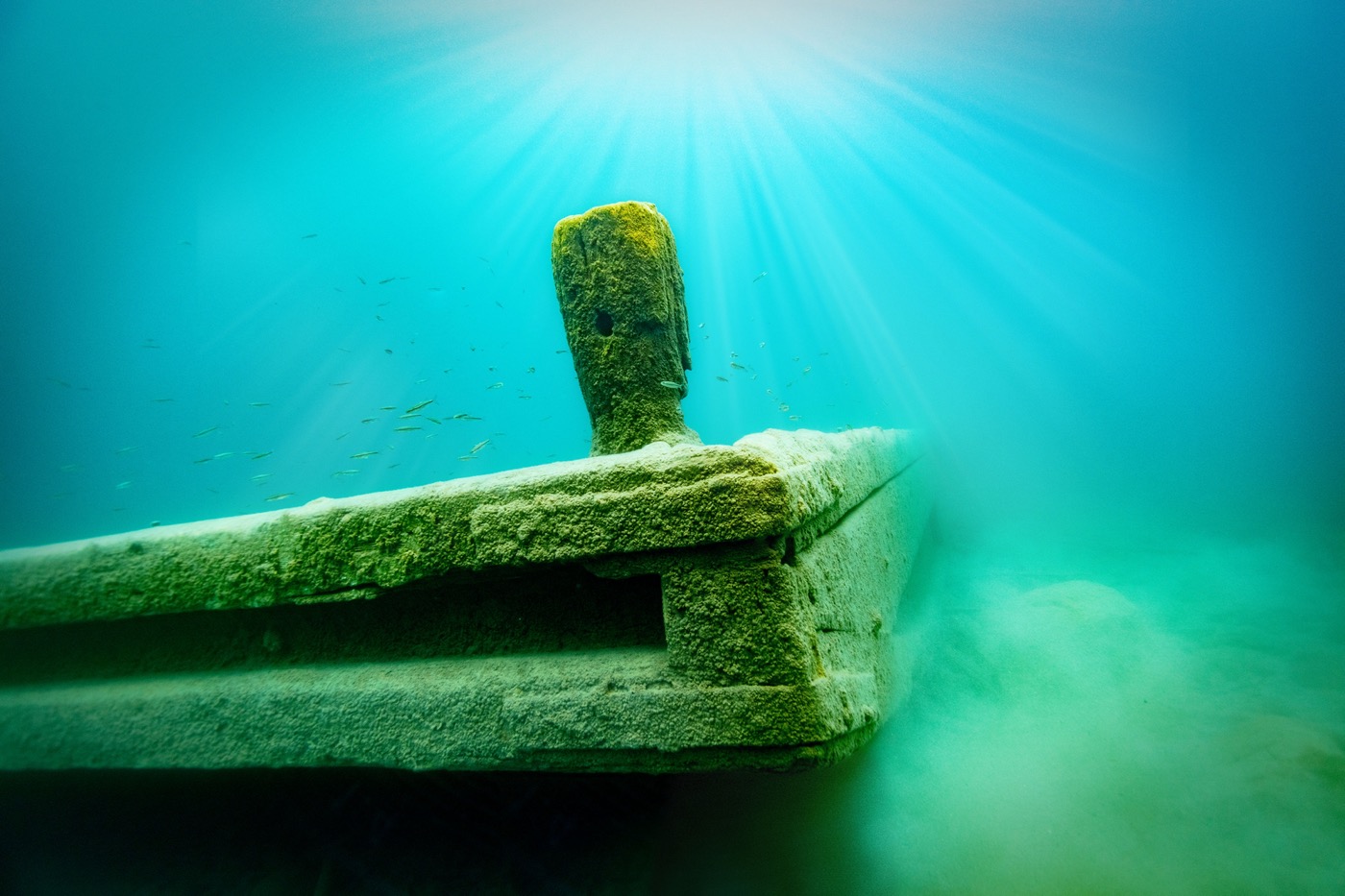Lake Tahoe has long been a favorite destination for local divers, northern California dive shops seeking a calm place for training classes, and a few select technical divers who explore some of her deeper shipwrecks, such as the 300-foot deep SS Tahoe. The diving here is beautiful, with consistent 60-80 feet of visibility, no currents or tides to worry about, and many interesting sites with historic wrecks, vertical walls, and huge underwater boulders to explore.
Recreational shore diving is possible at Lake Tahoe, but accessible dive sites are generally very limited. On the west side of the lake, for example, the Rubicon Wall is one of the most beautiful advanced dives (with a rock wall falling almost vertically down to over 800 feet), but getting to it involves walking (with all your gear) down a winding trail with a 200 foot vertical drop to the beach, then about 600 feet of surface swimming to reach it. Add in the 6,224 feet of elevation, and it can be an exhausting workout, long before you begin your actual dive.

The Payah Kun anchored at the first dive site of the bay. The crystal clear waters and no waves, current, or surf make this an ideal way to scuba dive the lake.
ENTER THE PAYAH KUN
Long-time South Lake residents Tom Loomis and Sid Stimac operate a new dive boat that is now operating out of South Lake Tahoe. Their business, JustSoScuba, takes divers aboard their custom-built dive boat, the Payah Kun, carrying up to 6 scuba divers with speed, safety, and comfort to dozens of dive sites on Lake Tahoe. Launching out of South Lake Tahoe on the weekends, she can reach the Rubicon Wall and Emerald Bay dive sites in under 20 minutes, offering plenty of time to enjoy the scenery above and below the water. For those looking for a day or two of diving on one of the world’s most beautiful lakes, it’s definitely something to add to your schedule this summer.

Divers on the Payah Kun are treated to plenty of deck space and large benches for gearing up before the dive. The charter provides 80-cubic foot tanks for all divers onboard, which reduces the amount of gear you’ll need when driving up to the lake. They’ll also provide regulators, BCDs, and some other equipment available as rental gear, if needed. Onboard, there is inside seating also available for those wanting to get out of the sun, a private dressing area, and marine toilet (head) available.
EXPLORING THE LAKE
I enjoyed a day on the lake on the Payah Kun on July 16, and had a chance firsthand to enjoy Tahoe’s only dive charter boat and a couple of the best sites on the lake. Our first dive was my favorite destination here – the famed Rubicon Wall.

Divers enter the water near the famous Rubicon Wall
After arriving and setting anchor, we began by just relaxing and enjoying the scenery and pine-scented fresh air. With an air temperature of 80 degrees and water temperature of 72 (at the surface), it’s pure enjoyment to just be out here and away from the city for a weekend. The schedule for a day of diving on the Payah Kun is basically no schedule at all – 2 dives with plenty of time before, after, and in-between to enjoy the water and take in the gorgeous scenery. There’s never any rush to gear up and get in the water, and long dives aren’t a problem either for those who are good with their air consumption – if you’re a 90-minute per dive diver, you’re welcome to stay down with no pressure to stick to a schedule. As an experienced diver myself, I enjoyed the pace of the day, and I’m sure that newer divers would appreciate it even more.

Deckhand John helps keep everything running smoothly on the Payah Kun
DIVING DRY – OR WET
The prime diving season at Lake Tahoe runs from July through mid-October, and in late summer the shallower areas of the water warm up into the mid- to upper 70s. It’s great for swimming and snorkeling, but for scuba diving, you’re going to need a bit more insulation.
Once you drop below 20 or 30 feet, there’s an abrupt thermocline, and at diving depths of 40-100 feet the temperature is in the low 50s (and FYI, below an average depth of 600 ft, water temperature is a constant 39˚F, but you won’t need to worry about that.) A full wetsuit, including a hood and gloves are required here, and some divers opt for a drysuit, even in the summer. If you’re not a drysuit diver, you’ll be fine in a wetsuit however, especially since you’ll have plenty of time to warm up between dives on the boat.
DOWN THE WALL
The nicest thing about boat diving Lake Tahoe is that you can simply enter the water, drop down, and enjoy your dive – no lugging gear or surface swims needed. Today, we anchored very near shore and entered into about 20 feet of crystal-clear water, where you can clearly see the rocks, minnows, and sand below. After a giant stride entry, giving an “OK” signal to our divemaster and quick surface check, it was simply a matter of descending and following the underwater terrain to the edge of the wall. From there, we explored huge boulders, cliffs that mirrored the dramatic drop-offs you see above the waterline, and saw a few small fish and crawdads. Unlike ocean diving, you won’t see a ton of life in the water here when scuba diving.
Because we’re diving at an altitude of 6,200 feet, it’s very important to use a dive computer and understand how the altitude affects your dive profile. Due to the reduced atmospheric pressure, you’re limited to shallower depths, a safety stop is required at 12 feet, and there are other considerations as well. The divemaster on the Payah Kun will brief you on the changes you’ll need to make in your diving, but an altitude diving course from your local dive center is really the way to go if you’re diving here regularly.
After working out way back up the Rubicon Wall, we made our safety stop by simply swimming toward shore until we reached 12 feet. We surfaced right next to the boat (which you can see underwater from 40 feet away, which helps), climbed up the ladder, and our divemaster helped us back to the bench. With the gear off and after a beautiful dive, we had a few snacks and once again enjoyed the scenery and waving to a few passing boats.

Divers and crew enjoy a surface interval in Emerald Bay
OFF TO EMERALD BAY
A surface interval here at Lake Tahoe is not only necessary, it was one of the most enjoyable part of our trip. When everyone was back onboard and ready to go, we slowly motored to Emerald Bay, and were given a tour of the shoreline and Fannette Island. Waterfalls, ospreys, eagles – there’s no shortage of things to see here. The time on the Payah Kun is truly much more than a trip to a couple dive sites – it is truly a half-day tour of the lake and all its attractions.
For our second dive, we visited the historic barges, located near the southern shoreline of Emerald Bay. There’s a buoy here reserved for dive boats – and with so few divers visiting here it’s rarely used. The barges are located just below the buoy in 20 feet of water, and can easily be seen from the boat.

The Barges in Emerald Bay are a favorite shallow dive. Here you can explore the sunken barges which once carried goods all around Lake Tahoe, before the roads around the lake were built.
The site consists of two barges, built of massive Ponderosa pine timbers at a depth between 10 to 40 feet deep. The barges were owned and operated by the lumber companies, who used them to haul cordwood part of the year and then employed them as car ferries during the summer months. They were intentionally sunk in the 1950’s when they outlived their usefulness.
This second dive site was a great follow-up to the first. Being relatively shallow, we had no restriction on dive time here. Your bottom time will likely depend more on how well you are on air vs. your decompression status. Non-divers can snorkel above and dive down to the barges to experience them as well.
HEADING HOME
Needless to say, we had an incredible time diving Lake Tahoe, thanks in large part to our experience on the Payah Kun. Boat diving Lake Tahoe is much easier than shore diving, and having experienced divers running the operation made our dives both safer and much more more enjoyable. Having a dedicated dive boat to dive here is an great opportunity and I highly recommend making a trip up here this summer to experience it yourself.
BOOKING A TRIP
JustSoScuba accepts reservations on their website. They take up to 6 divers per trip, and with larger groups, they can schedule morning and afternoon trips to accommodate up to 12 divers. Divers can book individually or as a group, and dive shops and clubs can also charter the boat for the day. Reservations are first come, first served and some weekends do fill up.
The cost for diving on the Payah Kun is $225 each, which includes the tanks, dives at 2 different locations on the lake, a tour of some of Tahoe’s most beautiful areas (such as Emerald Bay), snacks, and a professional divemaster onboard. You’ll be diving at a relaxed pace and on the water for 5-6 hours. Dive shops, clubs and private parties may also choose to charter the full boat. Snorkelers are also welcome, and non-divers are also welcome aboard at a reduced rate. (Note that the cost to rent even a modest power boat on Lake Tahoe is $150 an hour, plus fuel, so $225 for a half-day on the lake – including tanks, food, and an experienced crew – isn’t a bad deal).
Just So Scuba owner Tom Loomis encourages divers to reserve their place in advance, and reservations are first come, first served. It’s also important to remember that the summer dive season ends in October, leaving just a few months left to dive with Just So Scuba. Reservations can be made online by visiting their website, emailing them at info@justsoscuba.com, or by phone at (530) 416-8519. At last check there are still a few spots open for the upcoming weekends.

MORE INFORMATION
JustSoScuba – Tahoe Charter Boat Information and Reservations
.
Words & Photos by Chris Constantine, California Diver Magazine

